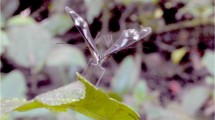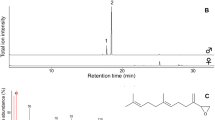Abstract
Abdominal defensive glands of both sexes of the Gulf fritillary butterfly, Agraulis vanillae (Linnaeus) (Nymphalidae:Heliconiinae)emit a pronounced odor when disturbed. We have identified 6-methyl-5-hepten-2-one; oleic, palmitic, and stearic esters of the corresponding alcohol 6-methyl-5-hepten-2-ol; hexadecyl acetate; 1,16-hexadecanediol diacetate; and 1,15-hexadecanediol diacetate in the glandular exudate. Since we have determined that free-flying birds or birds in a butterfly conservatory discriminate against A. vanillaeas prey, we suggest that the constituents in the glands may play a defensive role against potential avian predators.
Similar content being viewed by others
REFERENCES
ELTRINGHAM, H. 1925. VI. On the abdominal glands in Heliconius(Lepidoptera). Trans. Entomol. Soc. London. Parts I and II.269-275.
EMSLEY, M. G. 1965. Speciation in Heliconius(Lep., Nymphalidae): Morphology and geographic distribution. Zoologica50:191-254.
GLASSBERG, J. 1999. Butterflies Through Binoculars: The East. Oxford University Press, New York, 242 pp.
HAAHTI, E. O. A., and FALES, H. M. 1967. The uropygials: Identification of the unsaponifiable constituent of the diester wax from chicken preen glands. J. Lipid Res.8:131-137.
LINNAEUS, C. 1758. Systema naturae per regna tria naturae, secundum classes, ordines, genera, species, cum characteribus, differentiis, synonymis, locis. Editio decima, reformata. Laurentii Salvii, Holmiae. 1. p. 482.
MüLLER, W. 1886. Südamerikanische Nymphalidenraupen: Versuch eines natürlichen Systems der Nymphaliden. Zool. Jb.1:417-678.
NIJHOUT, H. F., and KOCH, P. B. 1991. The distribution of radiolabeled pigment precursors in the wing patterns of nymphalid butterflies. J. Res. Lepid.30:1-13.
ROSS, G. N. 1995. Everything you wanted to know about butterflies. 100+ questions and answers by Gary Noel Ross, PhD.Gary N. Ross, Baton Rouge, Louisiana, 52 pp.
ROSS, G. N. 1996. Gulf fritillary. La. Conserv.48:18-20.
ROSS, G. N. 1999. Butterfly gardens as scientific laboratories. Butt. Gard. News4:1, 4-7.
ROSS, G. N. 2000a. The tough guys! Butt. Gard. News5:3-5.
ROSS, G. N 2000b. Ten secrets to good butterfly gardening. La. Gard.Sept. 8-9.
TOMALSKI, M. D., BLUM, M. S., JONES, T. H., FALES, H. M., HOWARD, D. F., and PASSERA, L. 1987. Chemistry and functions of exocrine glands of the ants Tapinoma melanocephalumand T. erraticum. J. Chem. Ecol.13:253-263.
Author information
Authors and Affiliations
Rights and permissions
About this article
Cite this article
Ross, G.N., Fales, H.M., Lloyd, H.A. et al. Novel Chemistry of Abdominal Defensive Glands of Nymphalid Butterfly Agraulis vanillae. J Chem Ecol 27, 1219–1228 (2001). https://doi.org/10.1023/A:1010372114144
Issue Date:
DOI: https://doi.org/10.1023/A:1010372114144




